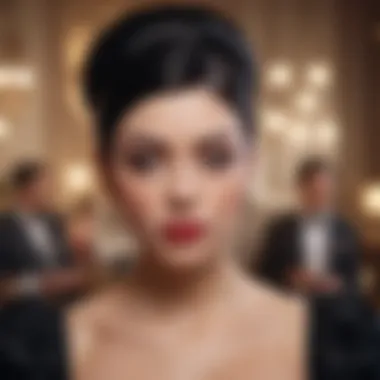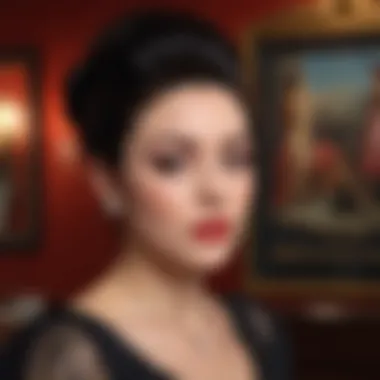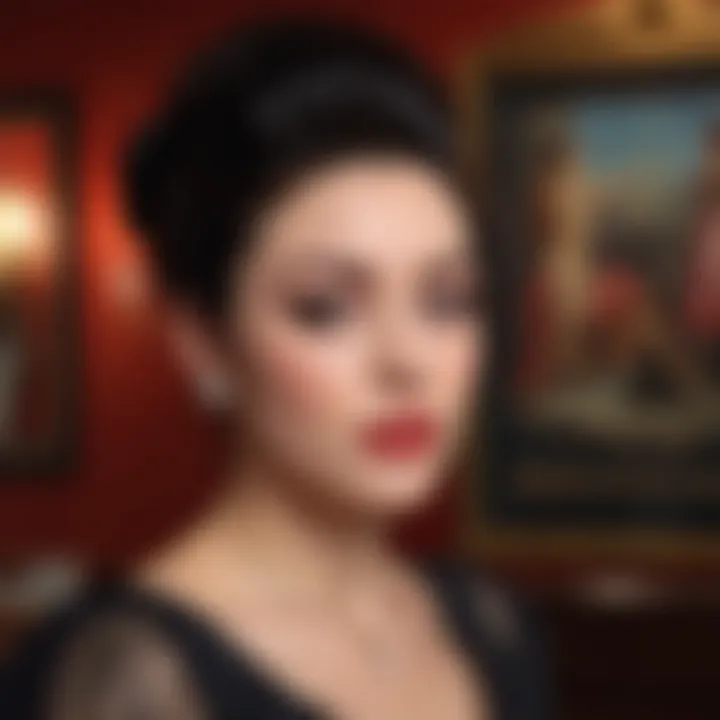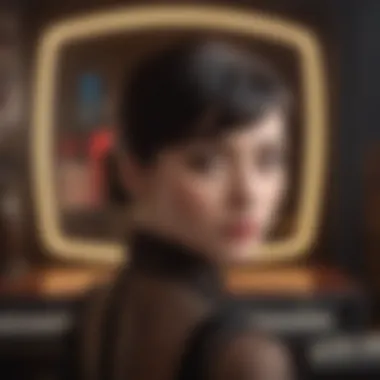Kiki de Montparnasse: Icon of Modern Art and Music


Intro
Kiki de Montparnasse is one name that resonates through the annals of 20th-century art and music. She was more than just a figure of beauty; Kiki was a muse, a guiding spirit who inspired some of the brightest minds of her time. Her presence not only colored the Parisian landscapes but also left an indelible mark on modern creativity and culture.
Born Alice Ernestine Prin in 1901, Kiki's life was woven into the very fabric of Montparnasse, a hub for artists and intellectuals. From her humble beginnings to becoming a celebrated figure among the avant-garde, her journey is both captivating and insightful. What led to her influence over so many artists? What were the connections and relationships that shaped her life?
This exploration summons the essence of Kiki's life—her vibrant energy, relationships with key figures, and the broader cultural milieu of her time. By diving deep into who Kiki was and understanding the forces that inspired her, we begin to grasp her lasting impact on modern art and music.
With that in mind, let’s unpack Kiki’s significance by delving into her background and the major influences that shaped her artistic journey.
Preamble to Kiki de Montparnasse
Kiki de Montparnasse stands out as a pivotal figure in the artistic evolution of the early 20th century. Her life intertwined remarkably with the cultural tapestry of that epoch, making her not just a muse but a symbol of an artistic millieu that thrived on creativity and innovation. Intriguingly, she was as much an artist as she was a model, leaving her mark not just on canvas but also in the hearts of those who breathed the same air of Parisian bohemia.
Kiki's significance goes beyond mere aesthetics; she serves as a lens through which we can explore the socio-cultural dynamics of her time. Understanding her role sheds light on how art and music coalesce and evolve, empowering aspiring musicians and artists to grasp the relational intricacies of their craft. Kiki embodied the spirit of experimentation and collaboration, pivotal elements that resonate even in today's creative landscapes.
In this article, we aim to dissect various facets of Kiki’s life, her significant connections with prominent artists, and the influence she wielded over music and modern art. By deep-diving into her early life, we will trace the pathways that led to her prominence. Her relationships with key figures like Man Ray exemplify the deep synergy present in creative communities, serving as case studies for anyone interested in the interplay of inspiration and artistry.
Reflecting on her legacy not only enriches our understanding of the past but also frames the discourse on the essence of being a muse in contemporary artistic expressions. In an age where raw emotion and personal experience are redefined in music and art, Kiki de Montparnasse’s life story becomes essential reading, bridging gaps between past and present.
"Kiki was not merely a subject of art; she was the heartbeat of Paris’s avant-garde scene."
This introduction sets the stage for the ensuing discussions by highlighting how Kiki’s legacy continues to influence modern creators, reminding us that the muses of yesterday propel the artists of tomorrow.
Early Life and Background
Understanding the early life and background of Kiki de Montparnasse provides a vital context for examining her role as a muse in the world of modern art and music. The experiences, relationships, and influences she encountered in her formative years laid the groundwork for her vibrant presence in the Montparnasse district, where she would become an icon.
Birth and Family Roots
Kiki de Montparnasse, born Alice Prin on 2nd October 1901, in Châtillon-sur-Seine, had familial roots that were as colorful as her later life. Her father worked as a laborer, and her mother, though a seamstress, struggled to support the family. This environment offered little in terms of artistic encouragement or financial stability. However, Kiki possessed a spirit that could light up any dark corner of her life. The family moved to Paris when she was just a child, a shift that would profoundly affect her destiny.
The early departure from a rural background to the bustling life of Paris had its share of challenges. Kiki often hinted that her family's modest means both stoked her ambitions and provided fuel for her artistic aspirations. In this city of lights, she would find the people and experiences that would shape her identity.
Childhood in Paris
Growing up in Paris during the early 20th century was like being a canvas to an ever-changing mural. Kiki experienced the vivid life of Parisian streets, filled with poets, artists, and a palpable sense of rebellion against traditional norms. This was the era when major artistic movements were swirling around her, and she soaked it all in.
Being a young girl in a bustling capital, Kiki had ample opportunities to observe the vibrant artistic community that blossomed in cafes and bars. Her childhood was marked by frequent visits to these lively places, where conversations about philosophy, art, and music flowed freely. Every encounter was a brushstroke on her canvas, every glimpse of creativity a potential influence.
It was here, amidst the laughter and discussions, that Kiki discovered her passions. She would later describe these formative experiences with a sense of longing, viewing them as both a grounding and launching point in her life.
Initial Artistic Influences
Kiki's world was rich with artistic influences from the very beginning. As she mingled among the artists and writers frequenting Montparnasse, she absorbed not only their ideas but also their lifestyles. This was a melting pot of creativity, where figures like Pablo Picasso and Amedeo Modigliani made their marks.
The performers and cafe patrons were, in many ways, her first teachers. She developed a keen appreciation for the visual arts and the power of expression through performance. The salons became informal classrooms, where Kiki learned about the freedom that comes with being true to oneself.
"The world is a tapestry, and I am but a thread in its great design."
Though still very young, Kiki's exposure to such artistic dynamism sparked the desire to embrace her unique identity and made her acutely aware of the transformative potential of art and music. This inner drive would soon be recognized, as she transitioned from an observer to an iconic figure within these circles.
Kiki's early life, with its blend of struggle, discovery, and artistic awakening, was pivotal in shaping the woman who would soon capture the hearts and imaginations of those around her. Her roots not only connect her to her past, but they also propel her into a future filled with endless possibilities, firmly establishing her as a beacon of creativity in Montparnasse.
Rise to Prominence


Kiki de Montparnasse rose to prominence during a pivotal period in the early 20th century when Paris became the epicenter of artistic and cultural innovation. Her ascent entwined with the vibrant streets of Montparnasse, where creativity flowed as freely as the wine in its bustling cafés. This section explores how Kiki emerged not just as a personality but as a critical figure who inspired the very essence of modernist art and music, highlighting elements that contributed to her unique status.
Montparnasse: The Bohemian Hub
Montparnasse was a buzzing hive of artists, writers, and thinkers. The neighborhood attracted individuals who were not afraid to push boundaries, and Kiki was at the heart of it all. She became a regular at popular haunts like Le Dôme and La Rotonde, where intellectuals gathered in search of inspiration over late-night discussions. Here, the interplay of various art forms flourished, and Kiki's presence enriched this environment.
Her friendships with notable figures such as Pablo Picasso and Gertrude Stein cemented her role within the community. They saw in Kiki not just a muse but a catalyst for artistic exchange. Artists painted her, drew her, and celebrated her in their works. As a result, she transformed into a living embodiment of the spirit of modernity, reflecting the innovative energy of the time.
Furthermore, the countless portraits of her by celebrated artists showcased her unique beauty and charm, giving her a kind of symbolic status. Kiki stood out not just for her artistic allure, but also for her embodiment of the emancipated woman, breaking away from traditional societal constraints. The café society where she thrived represented a new model for women—one of independence, creativity, and agency.
Becoming a Symbol of Art Deco
As the 1920s rolled around, Kiki began embodying the Art Deco movement—a significant shift in the visual and decorative arts characterized by geometric shapes and bold colors. Unlike the previous movements that leaned heavily on romantic ideals, Art Deco embraced modernity, innovation, and even the machine age. Kiki, with her striking features and expressive spirit, mirrored these ideals through her very existence.
She became synonymous with the glitz and glamour that defined the Art Deco era. Artists frequently used her image to express the bold, dynamic aesthetics of the time. Her sultry persona and sophisticated style complemented the movement's characteristics, making her an essential reference point in the visual revolution of the period.
Kiki was featured in many artistic representations that embraced this new style. From confident poses in vivid colors to her elegant silhouettes against opulent backdrops, she was both subject and symbol. It was through these representations that she helped define the spirit of Art Deco, making her mark on art history in a way that resonates even today.
"Kiki was not just a muse; she was the very essence of modernity at Montparnasse. Artists enhanced their works by capturing her vibrant spirit and the zeitgeist of the era."
In this manner, Kiki de Montparnasse exemplified the rise of artistic talent and innovation, acting as a muse who truly personified the cultural revolutions of her time.
Kiki’s Role as a Muse
Kiki de Montparnasse stands as a prominent figure in the world of modern art and music, celebrated primarily for her role as a muse to many leading artists and musicians of her time. Kiki transcended mere association with artists; she became an inspiration that fueled creativity and innovation. Her essence captivated the likes of Pablo Picasso, Man Ray, and many others within the vibrant artistic community of Montparnasse. To understand Kiki’s significance, it’s essential to explore her profound impact and the specific elements that underscore her role as a muse.
Collaborations with Artists
Kiki's collaborations with artists were not only extensive; they were transformative. One might say her presence in a studio wasn't just about posing; it often generated an energetic spark that birthed new works of art.
When Kiki met Man Ray, a renowned photographer and painter, their relationship went beyond the personal, serving as a catalyst for both of their artistic expressions. Ray's photographs of Kiki, such as the iconic Le Violon d'Ingres, captured her allure and sophisticated depth, leading to a reinterpretation of female beauty in the art of that era. Kiki also referenced themes of joy, liberation, and experimentation in her own works, often becoming the centerpiece in a gallery of artistic exploration.
Notably, she often posed for portraits by artists who sought to encapsulate the new, modern feminine spirit. The vigor of Kiki's character and her vibrant lifestyle resonated with artists who thrived in the early 20th-century movement.
Key Collaborations Include:
- Pablo Picasso: Kiki was the muse for several of Picasso's works, where her imagery often symbolized a new kind of modern femininity.
- Amedeo Modigliani: Kiki's visage in Modigliani's art illustrates his signature elongation style, creating a unique dialogue between his technique and her charm.
- André Derain: Captured her expressive eyes and lively spirit, showcasing the intimate connection between artist and subject.
These artists were inspired not just by Kiki's physical beauty but also her vibrant personality, creating a rich tapestry of collaboration that defined an era.
Influence on Music and Performance
Apart from her visual representation in art, Kiki de Montparnasse made significant inroads into the realm of music. Her influence resonated through the smoky jazz clubs and lively cabarets of Paris, which served as creative hotspots for musicians and performers.
Kiki was also a talented singer, often gracing stages where she would perform popular chansons of the time. Through her performances, she encapsulated the spirit of the Jazz Age, enchanting audiences with her unique charisma and a voice that captured the heart and soul of modernity. Her presence was magnetic, and she brought an authentic vitality that greatly enriched the experiences of those around her.
Her relationships with notable musicians, such as Josephine Baker and Erik Satie, helped to further her influence in this arena. They not only showcased her but also incorporated elements of her personality and life experiences into their music, creating a symbiotic relationship that expressed the artistic pulse of Montparnasse during that time.
"Kiki wasn’t just a muse; she was the flame that lit the creativity of her contemporaries."
Looking deeper, Kiki represents a bridge between the realms of visual art and music as she cultivated an atmosphere ripe for collaboration. The jazz tunes and bohemian beats of the period echoed her vivacity, allowing her to weave her narrative into the very fabric of the cultural landscape.
In summary, Kiki de Montparnasse's role as a muse is underscored by her vibrant collaborations with artists and her profound influence on music and performance. She was more than just a figure in the art world; Kiki was a living embodiment of creativity, a muse whose presence sparked a wave of artistic innovation and cultural significance.
Key Artistic Associations
Kiki de Montparnasse's connections to the artistic circles of her time weren't merely part of her social life; they were central to her identity and the lasting impact she had on modern art and music. Through her interactions with key figures, Kiki helped shape an era marked by innovation and creativity. This section scrutinizes her pivotal relationships and affiliations, dissecting how they ultimately influenced various art forms and propelled Kiki into the annals of history.


Relationship with Man Ray
Kiki's romance with the renowned photographer and painter Man Ray stands as one of the most celebrated artistic partnerships of the 20th century. Their relationship was not only passionate but also tremendously fruitful. Together, they created works that would become touchstones of Surrealism and Dadaism.
Man Ray, known for his avant-garde techniques, notably the "rayograph," utilized Kiki as both a subject and muse, capturing her essence through a lens that reverberated with both vulnerability and strength. He went so far as to create a series of images featuring Kiki that amplified her mystique to the wider world.
"Kiki is my one true subject; she is the embodiment of my work," Man Ray once commented, emphasizing Kiki’s influence in his artistic journey.
Through their collaborations, they established a visual language that combined abstraction and realism, presenting Kiki in ways that challenged traditional perceptions of beauty. Man Ray's explorations of light and shadow in his portraits, alongside Kiki's compelling visage, forged a powerful statement about identity and artistic freedom.
Connections to the Surrealist Movement
Kiki's involvement with the Surrealist movement was both direct and indirect. While she wasn’t formally affiliated with any specific group, her presence at Montparnasse—home to many Surrealists—allowed her to intermingle with the key players of that artistic revolution. Artists like André Breton and Salvador Dalí frequented the same cafés where Kiki was often found, making her a familiar presence amidst discussions and artistic experimentation.
The freewheeling ideas floating through these circles spilled into Kiki's life, influencing her thoughts and artistic expressions. She became a living embodiment of Surrealism's ethos, which sought to dissolve the boundaries between dream and reality. Her value as a muse stemmed from her ability to reflect this duality.
Many artists captured Kiki in their works, interpreting her through their unique lenses, often emphasizing the surreal aspects of her character. This interplay between artist and muse not only magnified Kiki's allure but also left a lasting mark on the movement itself.
Artistic Circle of Montparnasse
Montparnasse served as a backdrop for Kiki's life, replete with energy, experimentation, and camaraderie. This bustling district became a haven for artists, musicians, and thinkers who sought to break the confines of traditional art forms. In this setting, Kiki became a revered figure, moving seamlessly from one artistic gathering to another, engaging with talents that were shaping the future of art.
The artistic circle around Montparnasse included not just painters and sculptors, but also poets and musicians. Pablo Picasso and Fernand Léger often crossed paths with Kiki, who would enliven their interactions with her characteristic charm and insight.
Her ability to connect disparate artistic domains made her a vital catalyst for collaboration and innovation. Whether it was through hosting gatherings or participating in discussions, Kiki’s role in this mosaic of creativity was substantial. Her influence helped forge a distinctive identity for Montparnasse, making it synonymous with the flourishing arts of the 20th century.
As we look into Kiki's life, it's clear that her key artistic associations were not just personal but also foundational for the cultural fabric of her time. By nurturing relationships with figures like Man Ray and integrating into the broader artistic movements, Kiki de Montparnasse carved a niche that celebrated the confluence of art and life.
Cultural Impact
Kiki de Montparnasse's influence resonates beyond the visual arts and into the very fabric of modern culture. The relationship between her persona and the broader artistic movements of her time creates a vivid tapestry of creativity, expression, and rebellion. This segment examines how Kiki not only inspired artists but also shaped the narrative in literature and eventually left a mark on contemporary arts.
Representation in Literature and Music
Kiki's unique character and spirit were inherently tied to the artistic pulse of her era. Writers and musicians alike drew inspiration from her vivacity and allure, crafting stories and melodies that echoed her essence. Authors such as Amedeo Modigliani and Henri-Pierre Roché have portrayed her in their literary works, memorializing her as the quintessential muse of the avant-garde scene.
- In Literature:
Kiki's role in the Parisian art scene made her an archetype of the free-spirited, progressive woman. In Roché's Jules et Jim, which weaves a narrative around love and friendship, Kiki is not just a figure but a symbol of the modern woman—fierce, independent, and free. Authors like Gertrude Stein also noted Kiki's importance in their writings, often alluding to her as a reflection of the artist's own struggles and aspirations. - In Music:
The influence of Kiki reached a range of musicians. Jazz legends like Josephine Baker and others often referenced Kiki's zest for life in their lyrics and public persona. Songs capturing Paris's vibrant nightlife and artistic fervor, such as "Lily's Blues," often echo her vibrant image, making her a figure of aspiration in the creative realms of music.
Kiki's existence sparked dialogues in both literary and musical forms, ensuring her spirit thrived beyond her years and place.
"She is more than a muse; she embodies the very soul of Paris during its most liberated era."
— Literature enthusiasts have noted her pervasive influence.
Legacy in Contemporary Arts
The legacy that Kiki left behind remains as relevant as ever. The ripples of her influence can be seen in various contemporary practices where artists utilize her as a reference point or as a subject to explore themes of femininity and creative freedom.
- Visual Arts:
Many contemporary artists cite Kiki as a source of inspiration; they explore the dynamic between muse and creator. For instance, present-day painters borrow elements of her distinct style and the emotional intensity of her collaborations. Techniques reminiscent of the Cubist and Surrealist movements, with a modern twist, frequently feature Kiki's likeness. Artists like Kara Walker engage with her image to discuss the complexities of identity and representation in art today. - Performance Arts:
Kiki’s role as a performer in countless cabarets and clubs paved the way for modern interpretations of the performing arts. Today, many artists in theater and dance channels her spirit, emphasizing bold expression and unrestrained creativity. Such performances often include improvisational elements that tiptoe the line between reality and abstraction, mirroring the fluidity once embodied by Kiki herself.
In examining Kiki de Montparnasse's enduring impact, it becomes clear that her life story is a cultural lens through which broader societal shifts can be viewed. She exemplifies the intersections among art, music, and literature, demonstrating all the while that influence can transcend time, shaping artistic endeavors for generations to come.
Personal Life and Public Persona
Kiki de Montparnasse’s personal life and public persona played a crucial role in establishing her as a key figure in the art and music scenes of early 20th century Paris. The intricate dance of her private experiences and public image not only contributed to her allure but also shaped the way she was perceived by artists, musicians, and the broader cultural community. Her relationships, both romantic and platonic, formed the fabric of her identity, painting a vivid picture of a woman navigating the complexities of love, art, and fame amidst the vibrant yet tumultuous atmosphere of Montparnasse.
Romantic Relationships
Kiki's romantic life was a tapestry of passionate affairs, each leaving an indelible mark on her persona and her work. Perhaps most notably, her relationship with Man Ray, a pioneering photographer and filmmaker, placed her at the center of avant-garde creativity. Through Man Ray, Kiki found herself captured in striking portraits, such as Le Violin d'Ingres, which transformed her into an object of desire not only for him but for the art world at large. Her beauty and charisma became synonymous with the artistic revolution occurring during that period.


Yet her love life was not limited to one individual. She engaged with numerous artists and creative minds, fostering relationships that enriched her understanding of art and creativity. Each relationship revealed different facets of her character; it didn't just confine her to be a mere muse but allowed her to blossom as an artist in her own right. The emotions, joys, and heartbreaks from these liaisons fueled her spirit and creativity, drawing a sympathetic connection between her life and the art that surrounded her.
Kiki didn’t shy away from the vibrant social scene. Although some viewed her whirlwind romances as chaotic, they were a testament to her free spirit and her defiance of societal norms. In an era marked by conservatism, she forged her path through love, art, and passion, emblematic of the changing attitude towards women in creative spaces. Every affair, every heartbreak—these weren’t just personal narratives; they contributed to her legend, echoing through the halls of Montparnasse.
Kiki's Role in Parisian Nightlife
Beyond her romantic entanglements, Kiki embodied the essence of Parisian nightlife. The cafés and clubs of Montparnasse thrived with artists, writers, and musicians seeking inspiration and acceptance. Kiki was not merely a face in the crowd—she became a focal point of these vibrant gatherings. Her vivacity and wit drew people to her, creating an electric atmosphere wherever she went.
In places like the Chez Kiki, which she later owned, she offered a space where creativity flourished. The nightclub was a melting pot of art, music, and literature, attracting an eclectic crowd. Artists, thinkers, and musicians found solace and companionship in these lively gatherings, with Kiki often the center of attention, holding sway over the course of the night with her infectious charm.
The nightlife Kiki helped cultivate wasn’t just about revelry; it was a breeding ground for ideas and collaborations. The intimate exchanges and discussions held amidst the swing of jazz music allowed for new artistic movements to take shape. Kiki’s presence stirred inspiration in others—it stirred the air, igniting sparks that led to groundbreaking works, suffused with the essence of the time.
"Kiki was the very spirit of Montparnasse, embodying its free-spirited essence and its unapologetic embrace of creative expression."
Kiki’s role in Parisian nightlife was not merely social; it was foundational to the artistic community. Her influence extended beyond her immediate relationships and encompassed a broader cultural impact, contributing to the rich tapestry of modern art and music. She navigated her public persona with an artist’s grace, often blurring the lines between her identity and the creative forces that surrounded her, making her a legend of her time.
Decline and Later Years
Kiki de Montparnasse's later years are pivotal for understanding the full arc of her existence and the eventual fading of her once vibrant presence in the artistic world. The trajectory of her life during this period highlights the stark contrasts between her earlier fame and the solitude that followed. By examining this decline, we can grasp the complexities of her identity as both a muse and an artist, and how external circumstances can shape the narrative of a life once filled with creative fervor.
Transition from the Spotlight
As the roaring twenties came to a close, the landscape of art and society began to shift dramatically. Kiki, who had once been the heartbeat of the Montparnasse scene, found herself on the fringes. The rise of the Great Depression brought along economic hardships that affected not just artists but also the patrons who supported them. With fewer opportunities to showcase her talent, Kiki's role as a muse diminished, leading her to reflect on her identity beyond the spotlight that had defined her for so long.
Some might argue that this transition was fueled by a loss of relevance as new artistic movements emerged. However, it also reflected a broader cultural shift, where the carefree spirit of her youth was replaced by uncertainty and instability. Many of her contemporaries had moved on or passed, leaving Kiki to navigate a world that felt both foreign and familiar.
“To be a muse in the vibrant chaos of Montparnasse is one thing, but to find purpose in quiet solitude is another.”
The Impact of Changing Times
- Loss of key relationships: As artists ventured into different styles or sought new inspirations, Kiki began to lose touch with those who had once painted her and been part of her life.
- Economic instability: Many artists struggled to make a living, thus impacting Kiki’s ability to thrive in a circle that had once celebrated her.
- Evolving artistic landscapes: The rise of new artistic communities, like Surrealism, further shifted the paradigms she had been part of, leaving her seemingly out of place.
Final Years and Death
Kiki de Montparnasse's final years were marked by profound introspection and a retreat from the world that once adored her. As the bright lights of Montparnasse faded into memory, she returned to her roots, living a quieter life away from the tumult of Parisian nightlife. Her health began to wane, and the vibrant spirit that defined her youth seemed like a distant echo.
In the years leading up to her death in 1953, Kiki experienced a blend of nostalgia and regret. Although she penned her memoir, titled “Kiki’s Paris,” which illustrated her halcyon days amidst the artists and musicians, it was more a testament to her resilience than a bid for renewed fame.
The end of Kiki's life symbolizes a poignant reminder of the impermanence of fame and the paths we carve through the fabric of artistic communities. She died in a modest apartment, a stark contrast to her past existence amid the luminaries of modern art.
This period encapsulates her unique legacy—one that emphasizes not just her colorful past, but also her enduring influence on the artistic community, which still acknowledges her contributions.
- The final years of Kiki raise essential questions about:
- The nature of artistic relevance.
- The impact of societal shifts on an artist’s life.
- How personal evolution can often mirror public perception.
Kiki de Montparnasse may have transitioned into obscurity, but her story remains a beacon of the life of the artist, navigated amid the brimming vibrancy and the inevitable solitude that life imparts.
Finale
The conclusion of this exploration into Kiki de Montparnasse serves as a reflective touchpoint, bringing forth the essence of her contributions to modern art and music. Kiki wasn't just a figure caught up in the wave of artistic expression; she shaped that wave, leaving an indelible mark that resonates even today. Her influence stretches across various creative fields, and understanding her legacy helps to appreciate how interconnected art is to personal narratives.
Kiki's Enduring Legacy
Kiki de Montparnasse's legacy cannot be simply labeled. It's a rich tapestry woven through the lives of the artists and musicians who surrounded her; she inspired their work and, in return, absorbed the transformative power of their creativity. From the surrealist photography of Man Ray to the vibrant canvases of Amedeo Modigliani, her presence ignited a spark that fueled innovation.
Her image, immortalized in countless works, is a testament to her role as both muse and creator. Kiki’s influence can be boiled down into several key elements:
- Symbol of a Movement: As the epitome of the bohemian spirit of Montparnasse, she embodied the art deco and surrealist movements, providing a touchstone for subsequent generations of artists.
- Cultural Catalyst: Kiki catalyzed significant shifts within the cultural landscape of early 20th century Paris, acting as a bridge between visual arts and music.
- Inspiration for Future Art: Contemporary art still references her image and persona. She remains a muse for artists trying to capture the essence of individuality and the influence of creative spirit.
"Kiki was both the artist and the art; she lived her sensations and relationships, marking an era that cherished authenticity and spontaneity."
Ultimately, Kiki de Montparnasse's legacy is one of creativity and rebellion. Music enthusiasts and aspiring musicians can draw invaluable lessons from her life, understanding that the road to artistic expression often intertwines with resilient individuality. Her story reminds us that the soul of art lies in the relationships we foster and the influences we embrace. Through Kiki, we see that the role of a muse is not merely to inspire but to actively engage in the creative process—an enduring lesson for all who wander the vibrant paths of art and music.







